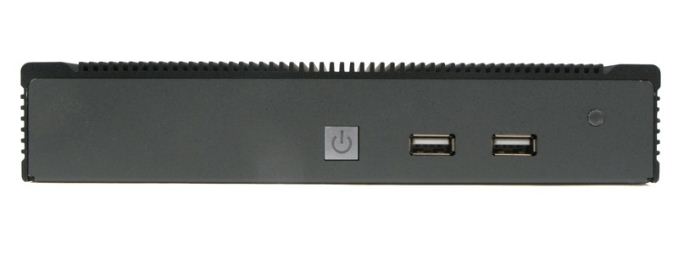Logic Supply Core-ML320 Fanless Industrial NUC Review
by Ganesh T S on April 30, 2014 3:45 PM EST- Posted in
- NUC
- Industrial PC
- Passive Cooling
- Logic Supply
Concluding Remarks
Coming to the business end of the review, it is clear that Logic Supply has been able to deliver effectively on the promise of a fanless NUC. The chassis has been designed to adapt the default NUC configuration for the requirements of industrial PCs. The online ordering page provides lots of options for customization. Even though the capacity choice of the SSDs in the review unit wasn't great, consumers do have the option of going in for larger sized SSDs if desired. That said, the DRAM options are top of the line, with full 1600 MHz support (instead of the 1333 MHz that some vendors put in, in order to cut down power consumption / thermal load).
Our only points of complaint are related to the size of the primary drive and the possibility of a better thermal design. On the former point, 32 GB simply shouldn't be an option, particularly when Windows is being presented as a OS of choice. A bare install followed by a couple of major updates is enough to cause disk space problems. It is also recommended that SSDs keep a fair amount of space free in order to maintain performance. A 32 GB mSATA drive simply can't be recommended. On the latter point, we found that parts of the chassis reached temperatures of 170 F+ under sustained heavy loading. A larger surface area for heat dissipation could have made the unit maintain a lower temperature profile even under high load.
Despite these minor quibbles (neither of which are show-stoppers), we have to say that Logic Supply's Core-ML320 is an excellent option for consumers looking for a passively cooled NUC. Its industrial components lend itself to a multitude of applications such as digital signage, kiosks and the like (even in harsh environments). For DIY builds and those finding the cost of a full-blown pre-built system too high, Logic Supply also sells the chassis standalone (ML320) for $139.











31 Comments
View All Comments
jcknows0 - Wednesday, April 30, 2014 - link
The chassis itself is a little on the pricey side. Its pretty hard to recommend a $1300 i5 system with less than 100 GB SSD space. I just built my latest NUC for under $300, just doesn't seem worth it for fanless.faiakes - Wednesday, April 30, 2014 - link
For Europeans, there is the very similar Alaska Tesla H. High-tech reviewed it and compared it to the Intel and another custom case herehttp://www.bit-tech.net/hardware/cases/2014/03/20/...WithoutWeakness - Wednesday, April 30, 2014 - link
The target market for these types of fanless, industrial, SFF machines is not the same target market as Intel's off-the-shelf NUC or Gigabyte's Brix. Fanless boxes like these are meant to be deployed in areas where the machine likely needs to be running 24/7/365 and any downtime is an order of magnitude more costly than the $1300 that the box costs. Overheating due to fan failures, untimely deaths of non-enterprise-grade SSD's (or, god forbid, platter-based hard drives), and other potential issues can be avoided by getting something like this box that is built specifically for the application. For other uses a NUC makes more sense (I bought a NUC to run as a cheap all-purpose media/backup/Mumble server and I love it) but for industrial and enterprise purposes you're far better off getting something like this.BryanC - Wednesday, April 30, 2014 - link
Why is it acceptable for a fanless industrial SFF machine like this to have an external power supply? Seems like that significantly complicates installation, especially in tight, cramped areas where this type of machine is attractive. Also, I'd be worried about the reliability of the power supply, it doesn't look like it's engineered to last.WithoutWeakness - Wednesday, April 30, 2014 - link
Not a clue. I definitely have to agree that an internal power supply would make the unit far easier to install because you wouldn't have to find a spot to put the brick. My best guess would be that it would make the unit larger and run hotter as the PSU would be unable to vent externally. Apple's Mac Mini is only slightly larger than this and has an internal PSU and 35W CPU but it also has a fan to help keep thermals in check.Mac Mini: 7.7" wide, 7.7" deep, 1.4" tall
Core-ML320: 7.72" wide, 5.17" deep, 1.45" tall
DanNeely - Wednesday, April 30, 2014 - link
Probably because of the optional 6-30VDC input jack. That's flexible enough that you should be able to wire it into the existing power system of whatever machine it's embedded in.evilspoons - Thursday, May 1, 2014 - link
This is exactly the reason. Every industrial panel I've ever installed a PC in already has a 24 VDC power supply for the rest of the control system.BryanC - Thursday, May 1, 2014 - link
Thanks, I learned something today! =)BedfordTim - Saturday, May 3, 2014 - link
I couldn't find the 6-30VDC input jack option on the website, but the NUC motherboard itself does have a 12-24V input. The motherboard manual is inconsistent about input voltages, and Intel haven't been very helpful in clarifying this.Lothsahn - Thursday, May 1, 2014 - link
One reason is that with the industrial market, they'll actually have a DC line they want to wire the devices into.